Tesla Model Y vs BYD Sealion 7: Which Electric SUV Wins in 2025?
The electric SUV market in 2025 is fiercely competitive, with the Tesla Model Y and BYD Sealion 7 vying for supremacy. Both promise cutting-edge technology, eco-friendly performance, and family-friendly practicality, but which one truly delivers? This ultimate comparison, informed by Carwow’s in-depth YouTube review (watch here), pits the updated Tesla Model Y against the all-new BYD Sealion 7. From design and performance to interiors and tech, we’ll uncover the winner for commuters, families, and EV enthusiasts. Updated April 2025.
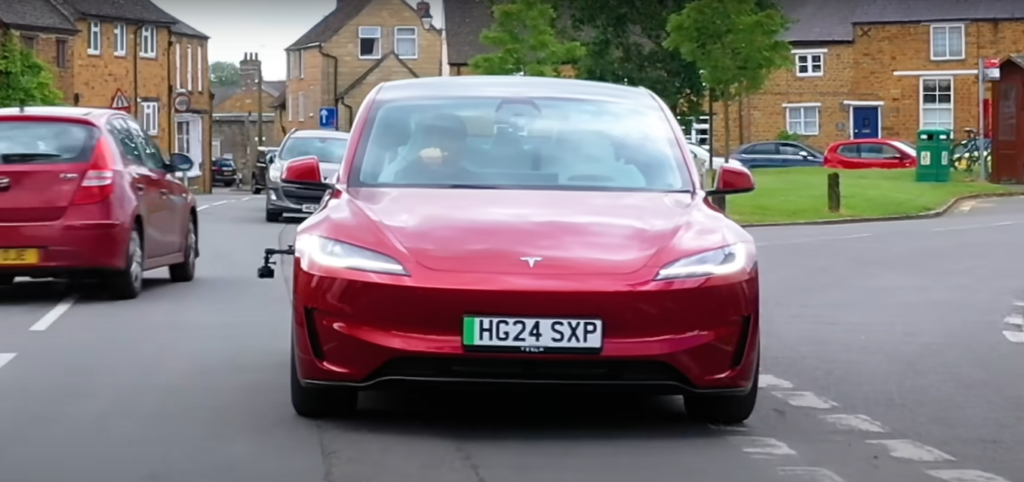
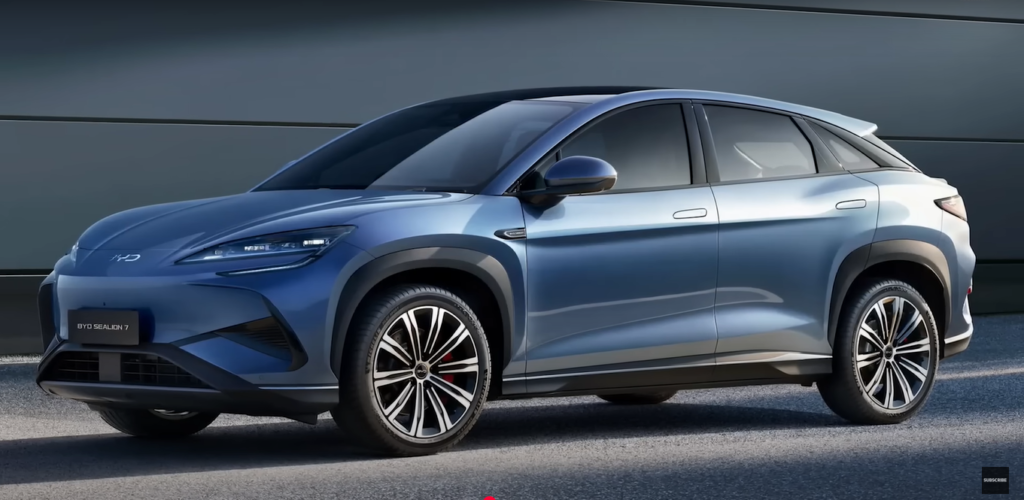
Pricing and Value: Premium or Overpriced?
- Tesla Model Y: Starts at £45,000 (~₹50.4 lakh), with the top-spec Long Range at £52,000 (~₹58.3 lakh). Offers Tesla’s Supercharger network access and competitive efficiency.
- BYD Sealion 7: Begins at £47,000 (~₹52.7 lakh), with the range-topping Excellence trim at £59,000 (~₹66.2 lakh). Includes more standard features but lacks Tesla’s charging ecosystem.
Analysis: The Model Y is cheaper at entry and mid-tier levels, aligning with Tesla’s reputation for value. The Sealion 7’s higher price reflects its premium interior and features like Apple CarPlay, but its cost may deter budget-conscious buyers. X users note Tesla’s lower running costs due to cheaper Supercharger rates (@EVFanatic), while BYD’s higher upfront cost is justified by its luxurious cabin (@TechBit).
Winner: Tesla Model Y for better pricing and charging savings.
Exterior Design: Bold vs Sleek
Tesla Model Y
Tesla’s 2025 facelift transforms the Model Y’s exterior, drawing inspiration from the Cybertruck:
- Front: New light bar with daytime running lights, redesigned bonnet, and wings for a futuristic look. However, the design traps insects, as reviewer Matt Watson found a bumblebee stuck in the grille.
- Side: Same egg-shaped silhouette, with new 20-inch wheel designs (19-inch standard). Frameless windows look sleek but struggle in icy conditions.
- Rear: Updated boot with a spoiler, illuminated Tesla logo, and relocated number plate, reminiscent of Porsche’s 911 evolution. Some X users dislike the lower number plate (@CarLad).
Drawbacks: Door handles remain tricky, requiring a two-step press-and-pull process, frustrating users. The unchanged side profile feels dated compared to rivals.
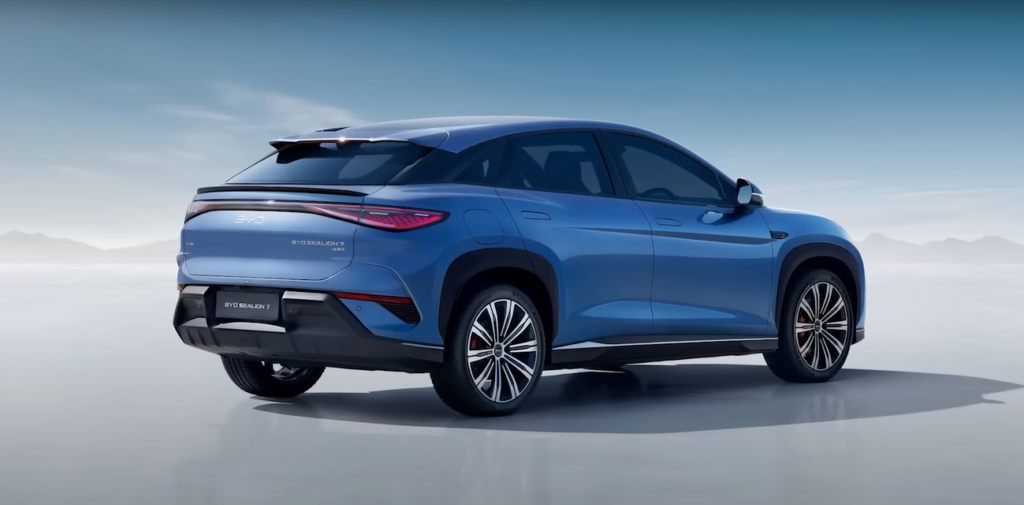
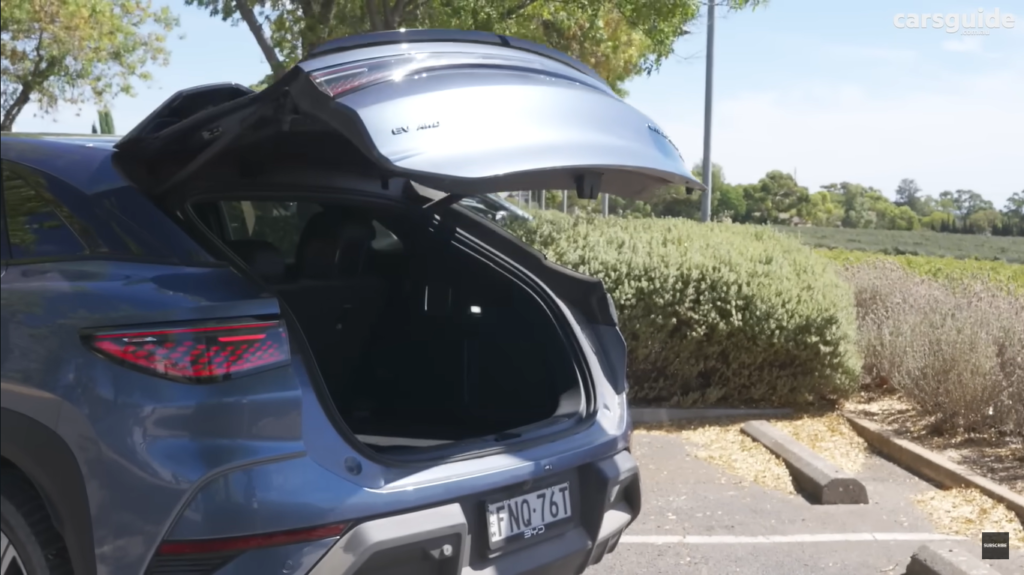


BYD Sealion 7
The Sealion 7, derived from BYD’s Seal saloon, adopts a sporty, aggressive aesthetic:
- Front: Anime-inspired face with Ferrari SF90-like lights and multiple vents for a bold, premium vibe.
- Side: 20-inch wheels (19-inch standard), but odd-shaped wheel arches with excessive cladding resemble the Toyota Yaris Cross, detracting from its sleekness.
- Rear: Full-length light bar and a subtle boot lip spoiler create an attractive, modern look, though excessive lower plastic feels cheap.
Advantages: Conventional door handles pop out with a press, offering ease of use over Tesla’s complex system. The design feels fresher, appealing to buyers seeking standout style.
Winner: BYD Sealion 7 for its distinctive, sporty design and user-friendly door handles.
Performance: Power and Agility
Both SUVs feature dual motors and all-wheel drive, but their performance differs:
- Tesla Model Y (Long Range): 457 horsepower, 494 Nm torque, 1,994 kg. 0-60 mph in 4.33 seconds, quarter-mile in 12.4 seconds. Real-world range: 278 miles (75 kWh battery).
- BYD Sealion 7 (Excellence): 530 horsepower, 690 Nm torque, 2,405 kg. 0-60 mph in 4.35 seconds, quarter-mile in 12.8 seconds. Real-world range: ~228 miles (91.3 kWh battery).
Drag Race Results: In Carwow’s tests, the Model Y outpaces the Sealion 7, winning both standing quarter-mile (12.4s vs 12.8s) and rolling half-mile races due to its lighter weight and sharper acceleration at higher speeds. The Sealion 7’s 0-60 mph time is nearly identical, showing strong initial pickup.
Driving Dynamics:
- Tesla: Firmer suspension with improved damping makes it “firm but fair,” offering nimble handling, responsive steering, and progressive brakes. It feels agile and controlled, ideal for spirited driving.
- BYD: Softer suspension prioritizes comfort but feels floaty over bumps, with disconnected steering and grabby brakes. It wallows in corners, lacking precision, though it’s playful for sliding.
Noise: At 70 mph with headwind, the Model Y is quieter, with less wind noise than the Sealion 7, enhancing cabin refinement.
Winner: Tesla Model Y for superior acceleration, handling, and refinement.
Interior and Comfort: Minimalism vs Luxury
Tesla Model Y
Tesla’s minimalist interior receives a 2025 upgrade:
- Materials: Improved Alcantara dash, ambient lighting hoop, and soft-touch surfaces extend to door bins, feeling premium. Seats are comfortable but less plush than BYD’s.
- Controls: 15-inch touchscreen handles everything—mirrors, wipers, steering adjustments, and drive selection—frustrating for quick tweaks. No stalks for wipers or drive select; one stalk for indicators.
- Features: No heads-up display, no Apple CarPlay/Android Auto, and a 15W non-cooled wireless charger that overheats phones. Storage is ample, with hidden cupholders and a large glovebox (accessed via screen).
Rear Seats: Spacious with reclining backrests, USB-C ports, and a rear touchscreen for apps. More knee room than BYD, but no ISOFIX on the front passenger seat.

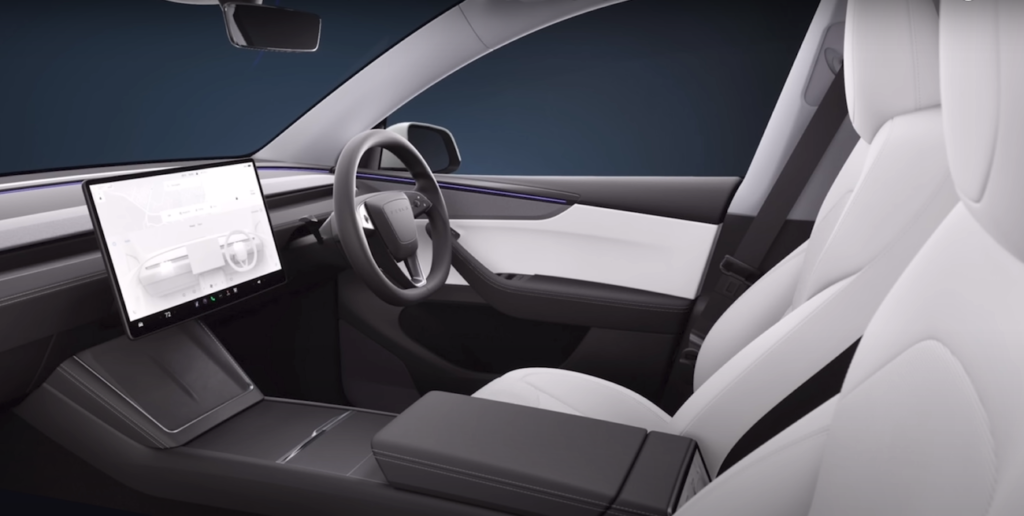
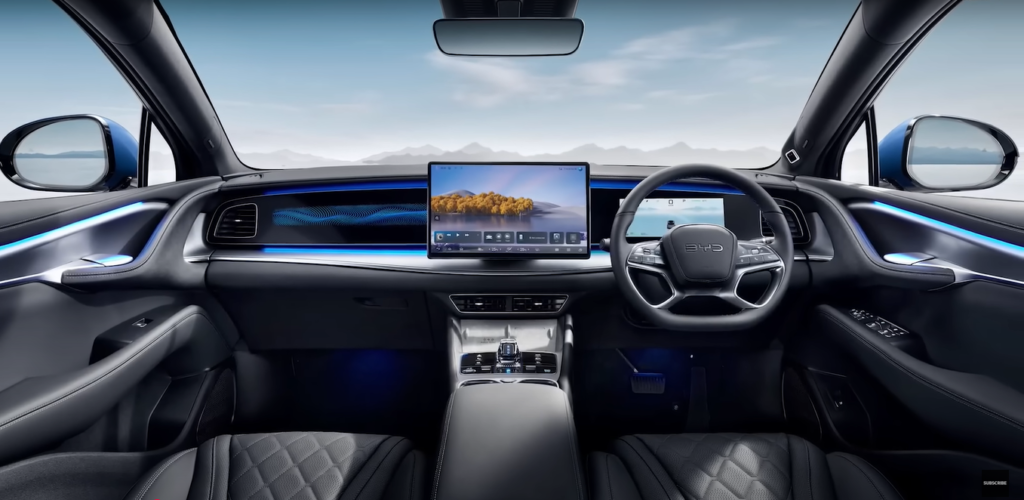

BYD Sealion 7
BYD’s cabin exudes luxury and practicality:
- Materials: Leather (or vegan option), wood-effect dash, and swooping door designs create a high-class feel. Seats are comfier, with finer leather, but lower plastics feel cheap.
- Controls: Physical buttons for climate, manual steering adjustment, and stalks for wipers/indicators enhance usability. A heads-up display projects speed, and a gear lever adds familiarity.
- Features: 50W cooled wireless charger, Apple CarPlay/Android Auto, and a 12V socket. Storage includes large door bins, a deep center console, and a clever expanding cupholder.
Rear Seats: More shoulder room for three adults, heated seats, and USB-C ports. Lacks Tesla’s rear touchscreen and through-loading but offers practical seatback pockets.
Winner: BYD Sealion 7 for its luxurious materials, intuitive controls, and connectivity features.
Technology: Innovation vs Accessibility
- Tesla Model Y: 15-inch touchscreen is sharp and responsive but lacks physical buttons, complicating adjustments (e.g., ventilated seats). No Apple CarPlay/Android Auto; games and streaming apps feel gimmicky. The satnav excels, auto-calculating charging stops and times for a 500-mile trip. Supercharger network access (cheaper for Tesla owners) is a major plus.
- BYD Sealion 7: Portrait touchscreen is less slick, with slower responses and less intuitive menus, but physical climate buttons improve usability. Apple CarPlay/Android Auto are standard, catering to most users. Satnav shows chargers but requires manual stop planning, less seamless than Tesla’s.
Winner: Tesla Model Y for its superior satnav and charging ecosystem, despite connectivity limitations.
Boot Space and Practicality
- Tesla Model Y: 854L boot (claimed), fitting four men in Carwow’s test. Electric-folding seats and a magnetic parcel shelf add convenience. Front boot fits a small person, outperforming BYD.
- BYD Sealion 7: 520L boot (claimed), fitting three men. Manual ratchet seats are less user-friendly, and the front boot is smaller. No through-loading limits versatility.
Winner: Tesla Model Y for larger, more practical boot space.
Battery and Range
- Tesla Model Y (Long Range): 75 kWh battery, 278-mile real-world range (3.7 miles/kWh efficiency). 10-80% charge in ~25 minutes at 250 kW DC chargers.
- BYD Sealion 7 (Excellence): 91.3 kWh battery, ~228-mile real-world range (2.5 miles/kWh efficiency, likely due to aggressive testing). 10-80% charge in ~30 minutes at 150 kW DC chargers.
Analysis: Tesla’s efficiency and access to faster Superchargers make it more practical for long trips. BYD’s larger battery is offset by lower efficiency, possibly from journalist thrashing.
Winner: Tesla Model Y for better range and charging speed.
Pros and Cons
Tesla Model Y
Pros: Lower starting price, superior performance, agile handling, efficient 278-mile range, advanced satnav, Supercharger access, spacious boot, improved interior quality.
Cons: Tricky door handles, no Apple CarPlay/Android Auto, screen-heavy controls, no heads-up display, frameless windows problematic in ice.
BYD Sealion 7
Pros: Luxurious interior, sporty design, Apple CarPlay/Android Auto, intuitive controls, heads-up display, comfortable seats, spacious rear.
Cons: Higher price, lower efficiency, floaty handling, smaller boot, slower charging, cheap lower plastics.
Which Electric SUV Should You Buy?
- Tesla Model Y: Ideal for performance enthusiasts, long-distance drivers, and those leveraging Tesla’s Supercharger network. Its agile handling, efficiency, and boot space suit families and commuters. Choose this if you prioritize driving dynamics and cost savings over luxury.
- BYD Sealion 7: Perfect for buyers seeking a premium cabin, modern connectivity, and standout design. Its comfort-focused ride and features like Apple CarPlay appeal to families and tech-savvy users. Opt for this if luxury and usability outweigh performance needs.
Final Verdict: The Tesla Model Y wins for its superior performance, efficiency, charging infrastructure, and practicality, making it the best electric SUV for most buyers in 2025. The BYD Sealion 7 impresses with its luxurious interior and connectivity but falls short in range and handling. If budget allows, the Sealion 7’s premium feel is tempting, but the Model Y’s all-around excellence seals the deal.
Price Check: Tesla Model Y (£45,000-£52,000) and BYD Sealion 7 (£47,000-£59,000) via Tesla, BYD, or Carwow.
Rating: Tesla Model Y (4.6/5), BYD Sealion 7 (4.3/5).
Still deciding? Share your priorities in the comments! Watch Carwow’s full comparison on YouTube (here) for drag races and boot tests. Check our Best Electric SUVs 2025 guide for more options.
Disclaimer: Insights are based on Carwow’s YouTube review, supplemented by expert analysis and X feedback (@EVFanatic, @CarLad). Prices are UK-based; Indian prices are approximate conversions.
Sources:
- Carwow YouTube Review (link)
- Carwow: Tesla Model Y Configurator
- BYD UK: Sealion 7 Specs
- X Feedback: @EVFanatic, @CarLad, @TechBit
Tesla Model Y is faster, with a 12.4s quarter-mile vs BYD’s 12.8s, excelling at higher speeds
Tesla Model Y Long Range offers a real-world range of 278 miles, outperforming BYD’s 228 miles.
Yes, BYD Sealion 7 includes Apple CarPlay and Android Auto, unlike Tesla Model Y, which lacks both.

